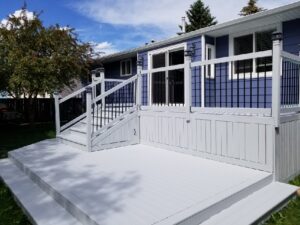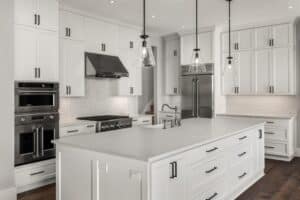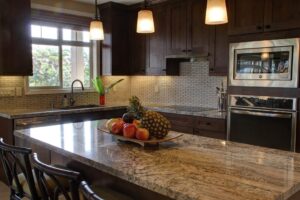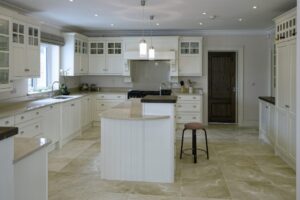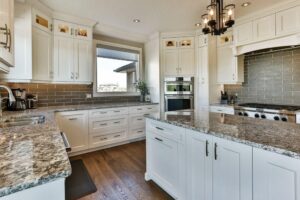Everything you need to know, courtesy of the experts at Mill Creek Painters in Edmonton
If you’ve ever researched the cost of new appliances, countertops, and cabinets, it’s no shock that renovating a kitchen is one of the most expensive remodeling projects. However, freshening the refinishing the cabinets that make up most of the room’s visual space is entirely feasible. But there’s a lot more to the job than buying a gallon of your dream colour.
Table of Contents
ToggleHow Much Does It Cost to Paint Kitchen Cabinets?
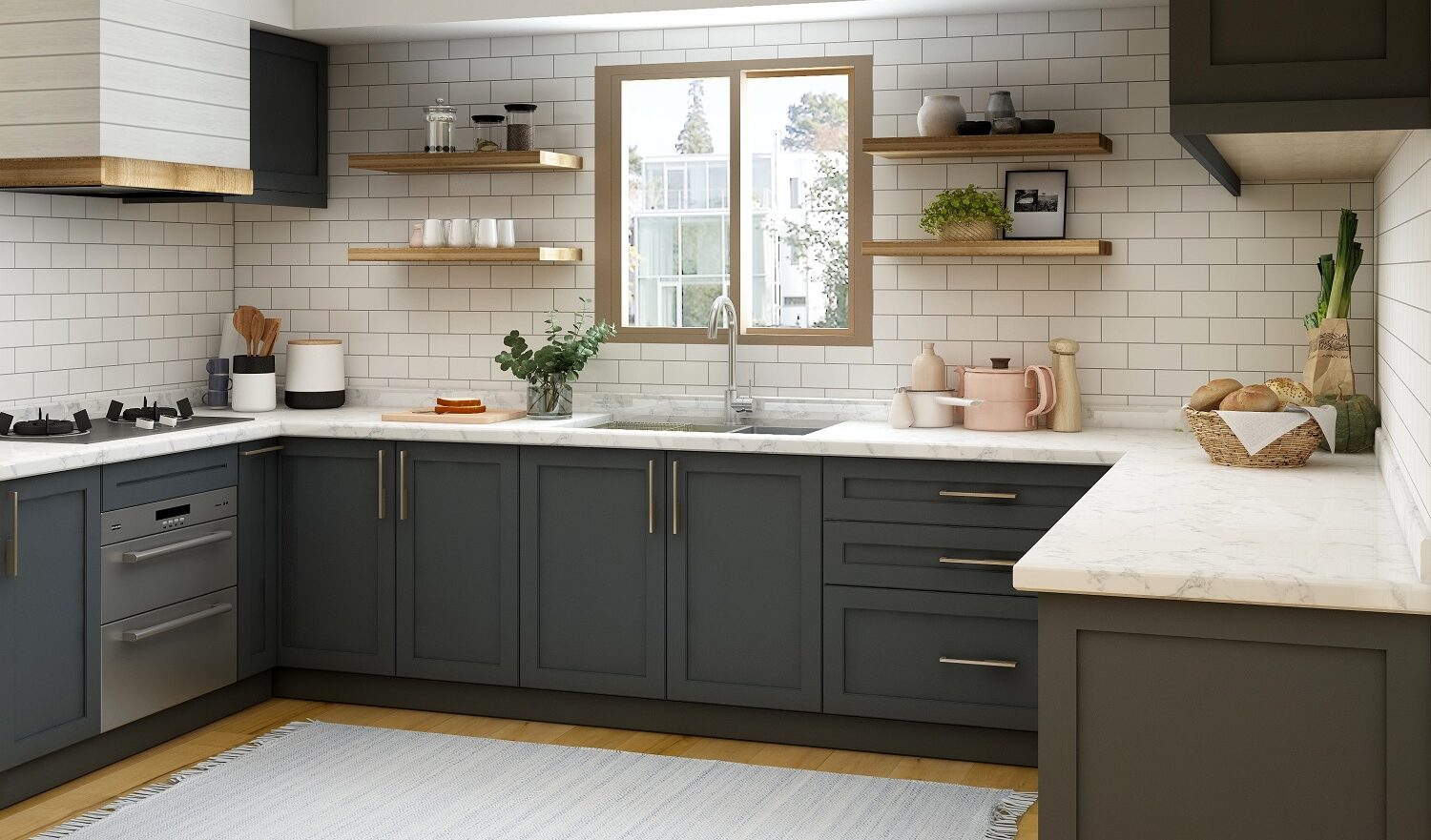
Renovating a kitchen is one of the most expensive remodeling projects that you can take on, and fully replacing the cabinets can account for nearly 40 percent of that cost. Cabinets for a 10-by 12-foot kitchen can easily top $10,000—and your new cabinets may actually be of lower quality than the ones you’re replacing. On the other hand, a few fresh coats of paint can go a long way toward transforming your existing cabinets for a fraction of that price. In fact, the cost of painting should be no more than about $200, plus a weekend (or two) of your time.
How Do I Know When It’s Time to Paint My Cabinets?
Before you head out to the paint store, however, examine your cabinets to see if they can be resuscitated in the first place. Even the highest-quality paint job can’t revive cheap cabinets that have grown frail with age. Thin veneers peel or delaminate, particleboard cabinet bottoms or shelves sag or break, and hanging rails come loose. If these are the issues you’re dealing with, you’d actually be better off completely replacing your kitchen cabinets.
Starting The Process
Materials to Consider
Paint – Look for a paint designed for a trim, often labelled enamel. The higher the sheen, the more durable the finish—a high gloss will stand up better than satin.
Roller – Use a 4- or 6-inch foam roller to cover the sides of cabinets and their face frames.
Square Brush – The straight end of a 3- to 4-inch-wide brush makes short work of large, flat panels.
Angled Brush – A synthetic angled brush in the 2½- or 3-inch-wide range helps you get paint into corners of doors with molding, and can coat door frames in one pass.
HVLP Sprayer – Not into the hand-brushed look? Spraying on a topcoat is the easiest way to get a smooth, factory-like finish. High volume/low-pressure sprayers are versatile enough to spray cabinets, fence panels, or exterior trim.
What Type of Paint Do I Need for Cabinets?
Oil or latex?
Latex paints have been improving steadily, leading some pros to give up oil-based paints entirely. Because they dry quickly and clean up with water, latex paints are more user-friendly than oil-based paints. However, many pros still prefer oil-based topcoats, making the claim that they form a harder, more durable paint film and level out to a smoother finished surface. Latex paints also take longer (up to three weeks) than oil-based paints to fully cure. It’s important to note that during this period, they’re susceptible to damage.
Bottom line: Either oil or latex will provide a good finish. If you do use a latex paint, make sure it’s a 100 percent acrylic formulation, which offers greater durability and adhesion than vinyl acrylic paints.
Brush or Spray Paint?
A sprayed-on finish is the smoothest option, but there’s a learning curve for doing it properly. You’ll also likely need to rent the spray equipment, which drives up your costs, and you’ll have to mask off all the areas in the kitchen that could accidentally get sprayed, including countertops, cabinet interiors, and appliances, which is a time-consuming process.

Taking those details into consideration, we suggest you invest in a good, 3- to 4-inch-wide square brush, whose straight ends will make short work of large, flat panels, as well as an angled brush in the 2½- or 3-inch-wide range, which will help you get paint into the corners of doors with molding and can coat door frames in one pass. Latex paint should be applied with a synthetic bristle brush, which doesn’t absorb water; oil-based paint should be applied with a natural-bristle brush.
Bottom line: Spray paint is a wonderful option that will provide great results once you’ve gotten past the learning curve. However, the equipment to do so is pricey and you run the risk of accidentally spraying unwanted parts of your kitchen if you don’t entirely mask them off. Instead, we recommend just buying a couple nice brushes and hand painting your cabinets.
Is it Okay to Paint Over Cabinets or Should I Strip Them?
When the existing finish is a clear coat, the best course of action is to strip the finish down to the bare wood before painting. This eliminates a potential adhesion problem between the old finish and the new paint.
Bottom line: While stripping may be ideal for purists, it’s not always practical or absolutely necessary. A thorough cleaning followed by light sanding should be enough to prepare the surface for new paint.
Regular or Faux Finish?
It all depends on what kind of look you’re going for. Incorporating a faux finish can transform its style into shabby chic, rustic, provincial, or modern. Crackling glaze, which you can find at most paint stores, can, with very little effort, give your cabinets a weathered look. Simply apply the glaze over a dry base coat, brushing in only one direction (thick for large cracks, thin for fine cracks), and let it dry. Finish with a flat topcoat of the base colour brushed on perpendicular to the glaze. The paint will start to form cracks as it dries, a process that takes about an hour.
If you’re looking for a rustic distressed look that doesn’t require special paint, you can build up your own finish by layering colours and spattering dark paint on top. When the paint is dry, to reveal the colours underneath, distress the finish by hitting it with a chain and lightly sanding in the spots where the cabinets get the most use.
Similarly, the antiqued, slowly aged look can be achieved with some paint magic. Simply dip the tip of a paintbrush in a colour lighter than the cabinets and dab the excess onto a cloth until the brush is almost dry, then lightly graze the surface of the detail trim, corners, and seams. Ooh la la!
Cloverdale Renaissance is a high-gloss finish, which will transform your kitchen into a polished, modern space. To shine up your cabinets, paint a high-gloss clear acrylic varnish over your final coat. This technique will add depth to the colour and cover the surface of your kitchen with a glassy sheen. So chic!
Conclusion
Painting kitchen cabinets can be a lot of work and it requires a lot of decision-making to ensure you end up with a kitchen you’re proud to show your friends and family. We encourage you to take the risk and try new things. But we want to remind you that painting professionals are available to help. Start with a free estimate here!


